Measurement for relative rural poverty suggested

A farmer harvests edible roses on a plantation in Bijie, Guizhou province. LUO DAFU/FOR CHINA DAILY
A report by the Chinese Academy of Social Sciences suggests that a level of 40 percent of the rural median income be used as a measure of relative poverty in less developed parts of the countryside.
Over the past decade, China has raised almost 100 million rural poor across the official abject poverty line, which was defined as a per capita income of 2,300 yuan ($321) a year in 2011, and which has been adjusted regularly for purchasing power parity since then.
However, a bench mark for identifying the relatively poor has yet to be determined, according to the annually published China's Rural Development Report, which was released on Monday in Beijing.
"Without progress on that front, all ensuing work cannot be properly carried out," the report said.
The measuring of relative poverty is a widely adopted practice in measuring poverty, and is based on a person's, or a household's, income or resources in comparison to the average income or resources of the society in which they live.
In developed economies, individuals or families earning less than 50 or 60 percent of the median income are generally considered poor. The European Union adopts nonnumerical factors, such as housing conditions, in addition to the 60 percent income threshold to determine relative poverty.
The report, compiled by researchers from the academy's Rural Development Institute, said that a level of 40 percent of median income is generally in line with China's socioeconomic goals and fiscal affordability.
Relative poverty is present both in urban and rural regions, though it is a more urgent challenge in the countryside.
The most important task in addressing the problem now is to quickly roll out a standard that can be used to track the phenomenon in rural regions, the report stated.
While affirming the "historic progress" made by the Chinese government to end absolute poverty, the report said that a sizable urban-rural wealth gap still exists, and a gap is also widening among rural residents themselves.
The earnings for low-income groups in the countryside have grown at an annual average rate of 6.39 percent in the decade since 2013. The report said that this is notably lower than the growth for wealthier groups in the countryside, which ranges between 8 and 9 percent.
Wang Changlin, a vice-president of CASS, said that as China works to achieve socialist modernization by the midcentury, the most arduous tasks remaining are found in rural areas. "In the last few decades, easier problems have been resolved in previous rural reforms, and those that remain are all difficult," he said during the report's release ceremony.
Photos
Related Stories
- Man introduces rural China in English on short-video platform
- Financial loans empower rural green development in southwest China
- Town in Zhejiang makes use of natural and tourism resources to boost rural revitalization
- Zhejiang launches Green Rural Revival Program
- Green Rural Revival Program lifts image of countryside in China's Zhejiang
- Agricultural Bank of China issues bonds for rural development
- Zhejiang implements rural green revival program to overhaul living environment of villages
- Inside China: Rural development
- Rural living gains popularity among Chinese urbanites
- China pledges efforts to expand demand in rural areas
Copyright © 2023 People's Daily Online. All Rights Reserved.









